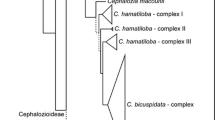Abstract
The results of a pilot DNA sequencing study of cycads conducted at the new molecular systematics laboratory at Fairchild Tropical Garden are presented and assessed with reference to previous phylogenetic analyses and classification schemes based on morphology and anatomy. Two DNA regions were sequenced and analyzed for variation, an intron in the trriL gene in the chloroplast genome (trriL intron) and the internal transcribed spacer region between the 5.8S and 26S ribosomal DNA subunits (ITS2). The trnL intron proved to be relatively conservative among cycad genera, while the ITS2 region contained higher levels of variation. Parsimony analysis of the sequences suggests a number of relationships, some of which were inferred by previous morphological studies, some of which are new. The sequences ofCycas are the most divergent among cycads, suggesting the longest isolation.Dioon is relatively isolated from the other genera and contains two major clades.Stangeria does not appear closely related toBowenia but does seem to have a weak affinity withZamia andMicrocycas. Lepidozamia is more closely related toEncephalartos than toMacrozamia. Sequence variation among the species ofCeratozamia is low.Microcycas andZamia are closely related.
Similar content being viewed by others
Literature Cited
Artabe, A. &D. W. Stevenson. 1999. Fossil Cycadales of Argentina. Bot. Rev. 65: 219–238.
Baldwin, B. G., M. J. Sanderson, J. M. Porter, M. F. Wojciechowski, C. S. Campbell &M. J. Donoghue. 1995. The ITS region of nuclear ribosomal DNA: A valuable source of evidence on angiosperm phylogeny. Ann. Missouri Bot. Gard. 82: 247–277.
Bayer, R. J. &J. R. Starr. 1998. Tribal phylogeny of the Asteraceae based on two non-coding chloroplast sequences, the trnL intron and trnL/trnF intergenic spacer. Ann. Missouri Bot. Gard. 85: 242–256.
Caputo, P., D. W. Stevenson &E. T. Wurtzel. 1991. A phylogenetic analysis of American Zamiaceae (Cycadales) using chloroplast DNA restriction fragment length polymorphisms. Brittonia 43: 135–145.
—,C. Marquis, T. Wurtzel, D. W. Stevenson &E. T. Wurtzel. 1993. Molecular biology in cycad systematics. Pp. 213–219in D. W. Stevenson & K. J. Norstog (eds.), The biology, structure, and systematics of the Cycadales: Proceedings of CYCAD 90, the Second International Conference on Cycad Biology. Palm & Cycad Societies of Australia Cycads, Milton, Queensland, Australia.
—,S. Cozzolino, L. Gaudio, A. Moretti &D. W. Stevenson. 1996. Karyology and phylogeny of some Mesoamerican species ofZamia (Zamiaceae). Amer. J. Bot. 83: 1513–1520.
Crane, P. R. 1988. Major clades and relationships in the “higher” gymnosperms. Pp. 218–272in C. B. Beck (ed.), Origin and evolution of gymnosperms. Columbia Univ. Press, New York.
De Laubenfels, D. J. de &F. Adema. 1998. A taxonomic revision of the generaCycas andEpicycas Gen. Nov. (Cycadaceae). Blumea 43: 351–400.
Doyle, J. J. &J. L. Doyle. 1987. A rapid DNA isolation procedure for small quantities of fresh leaf tissue. Phytochemical Bull. 19: 11–15.
Eckenwalder, J. 1980. Taxonomy of the West Indian cycads. J. Arnold Arbor. 61: 701–722.
Hillis, D. M., C. Moritz &B. K. Mable (eds.). 1996. Molecular systematics. Sinauer Associates, Sunderland, MA.
Johnson, L. A. S. &K. L. Wilson. 1990. Cycadatae. Pp. 362–377in K. Kubitzki (ed.), The families and genera of vascular plants, I. Pteridophytes and Gymnosperms. Springer-Verlag, Berlin.
Jones, D. L. 1993. Cycads of the world. Smithsonian Institution Press, Washington, DC.
Kvacek, Z. &S. R. Manchester. 1999.Eostangeria Barthel (extinct cycadales) from the paleogene of western North America and Europe. Int. J. Plant Sci. 160: 621–629.
Liston, A., W. A. Robinson, J. M. Oliphant &E. R. Alvarez-Buylla. 1996. Length variation in the nuclear ribosomal DNA internal transcribed spacer region of non-flowering seed plants. Syst. Bot. 21: 109–120.
Moretti, A., P. Caputo, S. Cozzolino, P. De Luca, L. Gaudio, G. Siniscalco Gigliano &D. W. Stevenson 1993. A phylogenetic analysis ofDioon (Zamiaceae). Amer. J. Bot. 80: 204–214.
Norstog, K. J. 1990. Studies of cycad reproduction at Fairchild Tropical Garden. Mem. New York Bot. Gard. 57: 63–81.
— &T. J. Nicholls. 1997. The biology of the cycads. Cornell Univ. Press, Ithaca, NY.
Sabato, S. 1990. West Indian and South American cycads. Mem. New York Bot. Gard. 57: 173–185.
— &P. De Luca. 1985. Evolutionary trends inDion (Zamiaceae). Amer. J. Bot. 72: 1353–1363.
Schutzman, B. &B. Dehgan. 1993. Computer assisted systematics in the Cycadales. Pp. 281–289in D. W. Stevenson & K. J. Norstog (eds.), The biology, structure, and systematics of the Cycadales: Proceedings of CYCAD 90, the Second International Conference on Cycad Biology. Palm & Cycad Societies of Australia Cycads, Milton, Queensland, Australia.
Stevenson, D. W. 1981. Observations on ptyxis, phenology, and trichomes in the Cycadales and thensystematic implications. Amer. J. Bot. 68: 1104–1114.
— 1986. Comments on character distribution, taxonomy, and nomenclature of the genusZamia L. in the West Indies and Mexico. Encephalartos 9: 3–7.
— 1990a. Morphology and systematics of the Cycadales. Mem. New York Bot. Gard. 57: 8–55.
— 1990b.Chigua, a new genus in the Zamiaceae with comments on its biogeographic significance. Mem. New York Bot. Gard. 57: 169–172.
— 1992. A formal classification of the extant cycads. Brittonia 44: 220–223.
—,S. Sabato &M. Vasquez Torres. 1986. A new species ofCeratozamia (Zamiaceae) from Veracruz, Mexico with comments on species relationships, habitats, and vegetative morphology inCeratozamia. Brittonia 38: 17–26.
Swofford, D. L. 1999. PAUP *: Phylogenetic analysis using parsimony (* and other methods) version 4.0d64. Computer program distributed by Sinauer Associates, Sunderland, MA.
Taberlet, P., L. Gielly, G. Pautou &J. Bouvet. 1991. Universal primers for amplification of three noncoding regions of chloroplast DNA. Plant Mol. Biol. 17: 1105–1109.
Thompson, J. D., T. J. Gibson, F. Plewniak, F. Jeanmougan &D. G. Higgins. 1997. The ClustalX windows interface: Flexible strategies for multiple sequence alignment aided by quality analysis tools. Nucl. Acids Res. 24: 4876–4882.
Author information
Authors and Affiliations
Rights and permissions
About this article
Cite this article
Bogler, D.J., Francisco-Ortega, J. Molecular systematic studies in cycads: Evidence fromtrnL Intron and ITS2 rDNA sequences. Bot. Rev 70, 260–273 (2004). https://doi.org/10.1663/0006-8101(2004)070[0260:MSSICE]2.0.CO;2
Issue Date:
DOI: https://doi.org/10.1663/0006-8101(2004)070[0260:MSSICE]2.0.CO;2




